Nitin Singhania Summary: Buddhism and Jainism | History for UPSC CSE PDF Download
| Table of contents |

|
| Buddhism |

|
| Basics about Buddha |

|
| Events associated with Buddha’s life |

|
| Early Buddhist Schools |

|
| Hinayana Buddhism |

|
| Mahayana Buddhism |

|
| Jainism |

|
Buddhism
(i) Origin- from the story of Siddhartha (Buddha) in the Indian subcontinent
(ii) Has now spread to large parts of Southeast Asia.
(iii) World’s fourth-largest religion after Christianity, Islam & Hinduism.
(iv) 7% of the world’s population embraces it.
(v) Buddhists- 0.7% of India’s population, or 8.4 million individuals, with the majority being in Maharashtra.
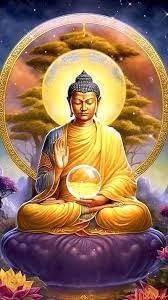 Buddha
Buddha
Basics about Buddha

(i) Born at Lumbini (in present Nepal) in 563 BC as Siddhartha Gautam
(ii) Mother- Maya & father King Suddhodana of Sakyan kingdom under Kshatriya clan.
(iii) Was born on Vaishakhi Purnima.
(iv) Was married to Princess Yashodhara & had a son named Rahul.
(v) At 29, left home with horse Kanthaka & charioteer Channa-> wandered as an ascetic for 6 years-^ went to Gaya (Bihar) & sat under a pipal tree, where he freed himself from all attachments & discovered the truth, the secret of happiness.
(vi) At 35- on his birthday, he attained enlightenment (Nirvana) under that pipal tree & became Buddha, the Enlightened One.
(vii) After attaining Nirvana in Bodh Gaya, his first sermon to his five companions was at Deer Park in Sarnath near Varanasi.
(viii) This event was called Dharma-chakra-pravartana (Turning the Wheel of Law).
(ix) The Three Jewels (Triratna) embraced under Buddhism are:
- Buddha- The enlightened one
- Dhamma- Teachings of Buddha (doctrine)
- Sangha- The monastic order
(x) Sangha (the Order) was initiated by Buddha at the time of giving the first sermon.
(xi) These 5 companions along with Buddha became Sangha (a group).
(xii) Buddha attained Mahaparinirvana at Kushinagar (Malla Mahajanapada) in UP at 80 in 483 BC.
(xiii) Said to be contemporary of King Bimbisara, for a major part of his life & for last few years to Ajatashatru of Haryanka Dynasty
(xiv) He is known for Buddhist texts- Tathagata & Sakyamuni.
(xv) Predecessor of Buddha under Buddhism- Kassapa Buddha & his successor will be Maitreya.
Events associated with Buddha’s life
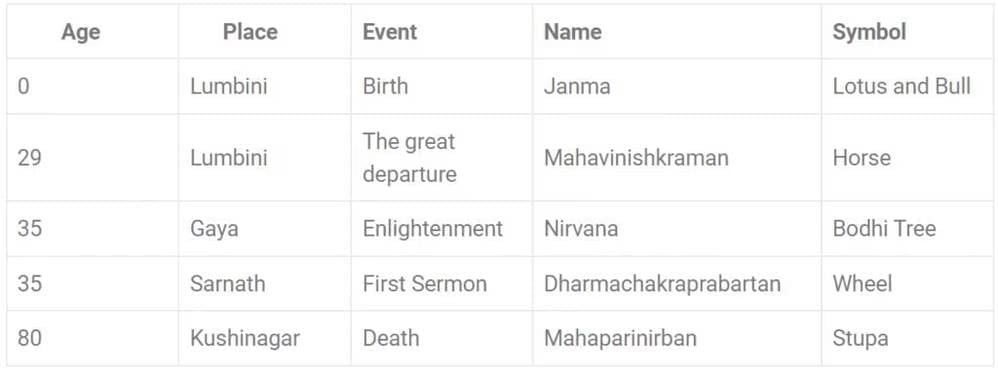
Early Buddhist Schools
(i) Original Sangha split into two early schools in between 383 BC & 250 BC:
- Sthavira nikaya (sub-sects included Mahisasaka, Sarvastivada, Sankrantika, Sautrantika, Dharmaguptaka, Vatsiputriya, Dharmottariya, Bhadrayaniya, Sannagarika and Sammitiya)
- Mahasamghika (sub-sects included Gokulika, Prajnaptivada, Bahusrutiya, Ekavyaharikas, Caitika)
(ii) Other sub-sects not in the above two schools- Hemavatika, Rajagiriya, Siddhatthaka, Pubbaseliya, Aparaseliya, and Apararajagirika.
(iii) Buddhist schools later included Theravada, Mahayana, Vajrayana, etc.
Concepts and Philosophy under
(i) Four major Noble truths:
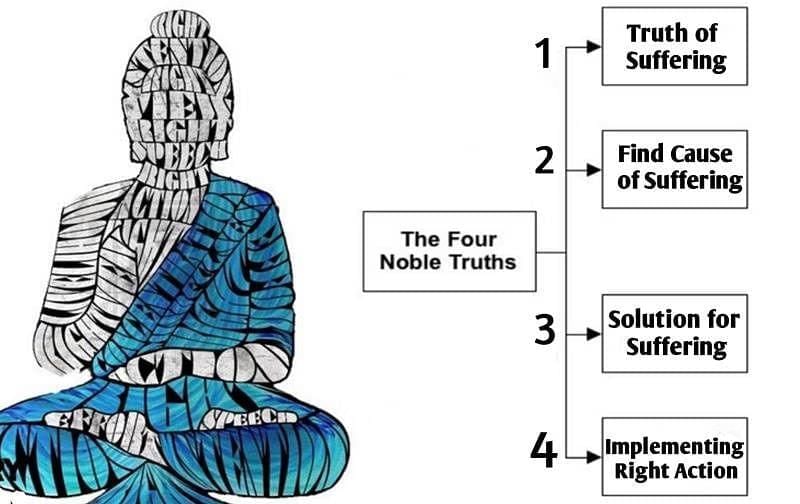
- Truth of suffering (Dukkha)
- Truth of the origin of suffering (Samudaya)
- Truth of the cessation of suffering (Nirodha)
- Truth of path to the cessation of suffering (Magga) i.e., Life is full of suffering (dukkha).
(ii) Desires cause sorrows, which keeps us caught in samsara, the endless cycle of repeated rebirth, dukkha, and dying again.
(iii) ‘Noble Eightfold Path’ includes:

- Kind, truthful & Right Speech
- Honest, peaceful & Right action
- Right livelihood which does not harm any being
- Right effort & cultivating self-control
- Right mindfulness
- Right meditation & concentrating on the meaning of life Right thoughts
- Avoid superstition & cultivate the right understanding.
(iv) Middle Path (Madhyam Marg) or Middle Way- describes the character of the Noble Eightfold Path that leads to liberation.
(v) Buddhism rejects the authenticity of the Vedas and the concept of the existence of Soul (atman) unlike Jainism.
(vi) After Buddha attained Mahaparinirvana at Kushinagar in 483 BC, his teachings were compiled by four Buddhist Councils in the next 500 years to collate this material into Pitakas.
(vii) Three major pitakas- Vinaya, Sutta & Abhidhamma (all combined-Tripitaka)- are written in Pali
(viii) In the Fourth council of King Kanishka’s reign- Buddhism split into two sects: Hinayana & Mahayana Buddhism Hinayana school declined & two new schools were born.
(ix) Four major schools so far:
- Hinayana Buddhism
- Mahayana Buddhism
- Theravada Buddhism
- Vajrayana Buddhism
(x) Practices of Buddhism- taking refuge in Buddha, Dharma & Sangha, the study of scriptures, observance of moral precepts, renunciation of craving and attachment, the practice of meditation, cultivation of wisdom, loving-kindness & compassion, Mahayana practice of bodhicitta & Vajrayana practices of generation stage and completion stage.
(xi) In Theravada the ultimate goal is the cessation of kleshas & attainment of Nirvana, by practicing Noble Eightfold Path.
(xii) Mahayana- aspires for Buddhahood via the bodhisattva path, a state wherein one remains in a cycle of rebirth.
Hinayana Buddhism
(i) It means the lesser vehicle.
(ii) Includes followers of the original preaching of Buddha.
(iii) Orthodox school.
(iv) Did not believe in idol or image worship of Buddha but believed in individual salvation through self-discipline & meditation.
(v) Ultimate aim- nirvana.
(vi) Sub-sects: Sthaviravada or Theravada.
(vii) Its scholars used Pali language.
(viii) Emperor Ashoka patronized this school.
(ix) Is almost non-existent in the present age.
 Hinayana and Mahayana Buddhism
Hinayana and Mahayana Buddhism
Mahayana Buddhism
(i) It means the greater vehicle.
(ii) More liberal & believes in the heavenliness of Buddha and Bodhisattvas embodying Buddha Nature.
(iii) Ultimate goal- “spiritual upliftment.
(iv) Believe in idol or image worship
(v) Bodhisattva- result of Mahayana Buddhism.
(vi) Also called “Bodhisattvayana”, or “Bodhisattva Vehicle.
(vii) Followers believe in Bodhisattva's concept of salvation or in universal liberation from the suffering of all beings.
(viii) Bodhisattva seeks complete enlightenment & one who accomplishes it is called Samyaksambuddha.
(ix) Prominent Mahayana texts- Lotus Sutra, Mahavamsa, etc.
(x) As per Lotus Sutra, Mahayana school believes in six perfections (or paramitas) to be followed by an individual: Dana (generosity), Sila (virtue, morality, discipline, and proper conduct), Ksanti (patience, tolerance, acceptance), Virya (energy, diligence, vigor, effort), Dhyana (one-pointed concentration), Prajna (wisdom and insight)
(xi) Sub-sects: Vajrayana.
(xii) Its scholars predominantly used Sanskrit.
(xiii) Emperor Kanishka (Kushana dynasty) - founder of Mahayana sect in the 1st century AD.
(xiv) Majority of Buddhist followers in the world belong to this sect, (around 53.2% as per the 2010 report).
(xv) Also followed in Nepal, Bangladesh, Japan, Vietnam, Indonesia, Malaysia, Singapore, Mongolia, China, Bhutan, Tibet, etc.
Bodhisattva in Mahayana Buddhism
(i) Bodhisattva- generated Bodhicitta (a spontaneous wish & a compassionate mind) to attain Buddhahood.
(ii) Believes in Universal liberation & is a concept under Mahayana Buddhism.
(iii) Jataka tales contemplate that Buddha was Bodhisattva, in his previous births.
(iv) Theravada Buddhism- a person whose aim is to become fully enlightened is still subject to birth, illness, death, sorrow, defilement, and delusion.
(v) On the path to becoming Buddha, a bodhisattva proceeds through ten grounds or bhumis- Great Joy, Stainless, luminous, radiant, very difficult to train, obviously transcendent, gone afar, immovable, good discriminating wisdom & Cloud of Dharma.
(vi) Prominent Boddhisattvas under Buddhism:
(a) Avalokitesvara:
- One of three protective deities around Buddha; holds Lotus & also known as Padmapani and depicted in Ajanta Caves.
- Most acknowledged among all Bodhisattvas.
- Appears unofficially in Theravada Buddhism in Cambodia under the name Lokesvara.
- Depicted as a female & said to incarnate as Dalai Lama.
(b) Vairapani:
- One of three protective deities around Buddha & depicted in Ajanta Caves.
- Manifests all the powers of Buddha & five tathagatas namely Vairocana, Akshobhya, Amitabha, Ratnasambhava & Amoghasiddhi.
(c) Manjusri:
- One of three protective deities around Buddha & depicted in Ajanta Caves.
- Wisdom of Buddha & a male Bodhisattva with a wielding sword.
- Avalokitesvara: Buddha’s compassion, Vajrapani: Buddha’s Power & Manjusri: Buddha’s wisdom.
(d) Samantabhadra: associated with meditation; with Buddha & Manjusri, forms Shakyamuni trinity,
(e) Ksitigarbha: Buddhist monk & vowed not to Buddhahood till the hell is emptied,
(f) Maitreva: A future Buddha; achieve complete enlightenment, & teach the pure dharma. Laughing Buddha- an incarnation
(g) Akasagarbha: element of space.
(h) Tara: associated only with Vajrayana Buddhism & represents virtues of success in work & achievements.
(i) Vasudhara: associated with wealth, prosperity & abundance. Popular in Nepal,
(j) Skanda: Guardian of viharas & Buddhist teachings.
(k) Sitatapatra: A protector against supernatural danger & worshipped in both Mahayana and Vajrayana.
Theravada Buddhism
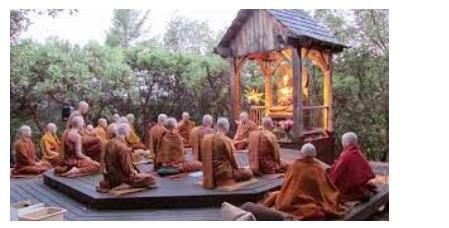 Theravada Buddhism
Theravada Buddhism
(i) School of elder monks.
(ii) Uses Buddha’s teaching preserved in Pali.
(iii) Canon (only existing complete Buddhist canon) as its doctrinal core.
(iv) Ultimate goal- cessation of kleshas & attainment of Nirvana,
(v) Kleshas include- states of mind such as anxiety, fear, anger, jealousy, desire, depression, etc.
(vi) Samatha (calming of mind) & Vipassana (insight into three marks of existence: impermanence, suffering, & realization of non-self.)- an integral part of Noble Eightfold Path.
(vii) Believes in the concept of vibhajjavada i.e., “teaching of analysis”.
(viii) Visuddhimagga (Path of Purification)- a treatise on Theravada Buddhist school (by Buddhaghosa in 5th Century AD in Sri Lanka).
(ix) Seven stages of purification (satta-vishuddhi) to be followed under it.
(x) Pali- sacred language of Theravada.
(xi) Successor of Hinayana.
(xii) 35.8% of Buddhists in the world belong to it.
(xiii) Followed in Sri Lanka, Cambodia, Laos, Thailand, Myanmar, etc.
Vajrayana Buddhism (Tantric Buddhism)
(i) Developed as a result of royal courts sponsoring Buddhism & Shaivism., i.e. influenced by Hinduism.
(ii) Main deity- Tara (a lady)
(iii) Combines Brahmanical (Veda-based) rituals with Buddhist philosophies.
(iv) Based on Mahayana Buddhist philosophy.
(v) Believes in Tantra’s, Mantras & Yantras.
(vi) According to this school, the mantra is an easy path to achieving Buddhahood as compared to Mahayana.
(vii) 5.7 % of the world's Buddhist population follows it.
(viii) Followed in Tibet, Bhutan, Mongolia, Kalmykia, etc.
Places visited by Buddha
(i) Kingdoms: Kosala & Magadha Kingdom.
(ii) Places: Kapilavastu, Rajgriha, Vaishali, Gaya, Bodh Gaya, Samath, Kosambi, Shravasti (capital of Kosala Kingdom), Kushinagar, Nalanda, Mathura, Varanasi, Saket, Champapuri, etc.
(iii) Prominent disciples of Buddha: Sariputta - chief disciple; Mahamoggallana - chief disciple; Ananda - listened to Buddha teachings; Mahakasyapa; Purna Maitrayani-putra; Anuruddha: Rahul; Katyayana; Upali; Ananthapindaka; Subhuti; Jivaka.
(iv) Other Prominent personalities:
- Nagasena: Answered questions on Buddhism posed by Menander I (or Milinda), the Indo-Greek king- recorded in the book Milinda Panho around 150 BC.
- Nagarjuna: (150 AD-250 AD) & founder of Madhyamaka school of Mahayana.
- Vasubandhu: Mahayana Buddhism in 4th-5th century AD from Gandhara & wrote from perspectives of Sarvastivada & Sautrantika schools.
- Bodhidharma: 5th or 6th century AD & transmitted Buddhism to China.
- Buddhaghosa: 5th-century; Indian Theravada Buddhist commentator & wrote Visuddhimagga (Path of Purification)
- Padmasambhava: 8th-century monk; called ‘second Buddha’ across Tibet, Nepal, Bhutan, & Himalayan States of India.
- Atisa: Buddhist Bengali religious leader; major figures in 11th-century Mahayana & Vajrayana Buddhism in Asia. Inspired Buddhist thought from Tibet to Sumatra.
- Dalai Lama: Modem spiritual leaders of Yellow Hat school of Tibetan Buddhism.
Navayana Buddhism
(i) New branch of Buddhism was propounded by Dr. B.R. Ambedkar.
(ii) Rejects Theravada, Mahayana & Vajrayana school.
(iii) Discards monk & monasticism, karma, rebirth in the afterlife, samsara, meditation, enlightenment & Four Noble Truths
(iv) Radically re-interprets Buddhism by revising the original teachings of Buddha to be about class struggle & social equality.
Jainism
 (i) ‘Jain’- derived from jina or Jaina meaning ‘Conqueror’.
(i) ‘Jain’- derived from jina or Jaina meaning ‘Conqueror’.
(ii) Believe that their religion is comprised of people who have managed to control & conquer their desires.
(iii) Has no founder, instead believes in the teacher who shows the way or a Tirthankara.
(iv) 23 Tirthankaras or great-learned men in Jain religion before Mahavira.
(v) Mahavira- last & 24th tirthankara.
(vi) Like Buddhism, rejects the authority of Vedas.
(vii) Unlike Buddhism, it believes in the existence of the soul (atman) as the core & fundamental focus of Jain philosophy.
(viii) Major Jain pilgrimages- Dilwara temple, Mount Abu (Rajasthan), Palitana temples (Gujarat), Girnar (Gujarat), Shikharji (Jharkhand), and Shravanabelagola (Karnataka).
(ix) The 24 Tirthankaras under Jainism are Rishabhanatha or Adinatha, Ajita, Sambhava, Abhinandana, Sumati, Padmaprabha, Suparshva, Chandraprabha, Suvidhi, Shital, Shreyansa, Vasupujya, Vimala, Ananta, Dharma, Shanti, Kunthu, Ara, Malli, Muni Suvrata, Nami, Nemi, Parshvanatha & Mahavira.
Basics about Vardhmana Mahavira
(i) Around 540 BC, Prince Vardhamana was born at Kundalgram in Vaishali to King Siddhartha & Queen Trishala, who ruled the Jnatrika clan.
(ii) At 30 → touching journey → to live the like an ascetic → 10th day of Vaishakha, reached Pava near Patna where he found the truth of life (Kevalya)
(iii) Title ‘Mahavira’ or the great hero was given.
(iv) Other titles- jaina or jitendriya (one who conquers all his senses) & nirgrantha (one who is free from all bonds).
Jaina Teachings and Philosophy
 (i) Mahavira taught- the right path or Dharma & stressed renunciation of the world, strict asceticism & moral cultivation.
(i) Mahavira taught- the right path or Dharma & stressed renunciation of the world, strict asceticism & moral cultivation.
(ii) Jains- live in such a way so as to not harm any being.
(iii) Anekantavada- the fundamental doctrine of Jainism emphasizes that ultimate truth & reality is complex, and has multiple aspects.
(iv) Hence, non-absolutism, which means no single, specific statement can describe the nature of existence and absolute truth.
(v) Believe in a three-jewel (fold) path of right belief (samyak darshan), right knowledge (samyak jnana), and right conduct (samyak charita).
(vi) Jains follow these five constraints:
- Ahimsa (non-violence); Satya (truthfulness); Asteya (not stealing); Aparigraha (non-acquisition) and Brahmacharya (chaste living).
- The fifth tenet was propounded by Mahavira.
Auspicious symbols under Jainism: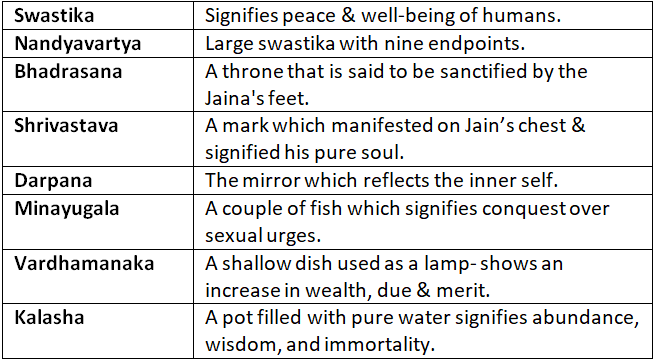
Two Major Schools or Sects under Jainism
Jainism- two major ancient sub-traditions:
- Digambaras [Sub-sects: Mula Sangh (original community) & Terapanthi, Taranpathi and Bispanthi (these three are modem communities)]
- Svetambaras (Sub-sects include Sthanakavasi & Murtipujaka) Several smaller sub-traditions emerged in the 2nd millennium CE.
Digambara School:
(i) Monks do not wear clothes as this sect believes in complete nudity.
(ii) Female monks wear unstitched plain white sarees & are_called Aryikas.
(iii) Follow all the five constraints (Ahirnsa, Satya, Asteya, Aparigraha, and Brahmacharya) as per the teachings of Mahavira, unlike Svetambaras.
(iv) Bhadrabahu (exponent of Digambara)- moved to Karnataka along with his disciples after predicting a long famine.
(v) Earliest record of Digambara beliefs- Prakrit Suttapahuda of Kundakunda.
(vi) Believe that women can’t be Tirthankaras & that Malli was a man.
(vii) Monasticism rules are more rigid under it.
Svetambara School:
(i) Follow preachings of Prasvanatha, i.e. believe in only four restraints (except Brahmacharya) to be followed to attain Kevalya.
(ii) Svetambara believes that the 23rd and 24th Tirthankara did marry, unlike thought by Digambara.
(iii) Sthulabhadra- great exponent of this school & stayed in Magadha, unlike Bhadrabahu who went to Karnataka.
(iv) Monks- simple white clothing, a begging bowl, a brush to remove insects from their path, books & writing materials.
(v) Believe Tirthankaras can be men or women, and say that Malli began her life as a princess.
(vi) Indicates five eternal substances in existence: Soul (jiva), Matter (pudgala), Space (akasha), motion (Dharma), and rest (Adharma), unlike Digambaras which add the sixth eternal substance as time (Kala).
Sub-sects under Digambara and Svetambara Schools
Digambara School: two major sub-sects:
(a) Mula Sangh: original community
(b) Bispanthi, Terapanthi, and Taranpanthi: modem community
Terapanthis vs Bispanthis
Terapanthis
- Worship the idols with ashta-dravya but replace flowers & fruits with dry substitutes.
- Sect opposes Bhattarakas and worships only Tirthankaras.
Bispanthis
- Worship the idols with ashta-dravya.
- Worship Tirthankaras as well as Yaksha & Yakshini like Bhairava and Kshetrapala.
- Religious practices- aarti & offerings of flowers, fruits, and prasad.
- Bhattarakas are their dharma-gurus and they are concentrated in Rajasthan & Gujarat.
Svetambara School: Three sub-sects:
(a) Sthanakavasi: pray to Saints rather than to idol; Saints wear muhapatti near their mouth to cover it, unlike Murtipujaka.
(b) Murtipujaka (Dcravasi): keep idols of Tirthankaras in temples; saints do not wear a muhapatti.
(c) Terapanthi: Pray to saints rather than to an idol like Sthanakavasi. Saints wear a Muhapatti.
Popular Practices under Jainism
- Sallekhana: Practice voluntarily fasting to death by gradually reducing your intake of food & liquids. Not considered suicide by Jain scholars because it is not an act of passion, nor does it deploy poisons or weapons. Can be performed by both Jain ascetics and householders. In 2015, Rajasthan High Court banned it, considering it suicide. Later that year, the Supreme Court of India stayed the decision of the Rajasthan High Court and lifted the ban on Sallekhana.
- Pratikraman: Jains repent for their sins during their daily life, and remind themselves not to repeat them. Five types of Pratikaman- Devasi, Rayi, Pakhi, Chaumasi & Samvatsari.
|
110 videos|652 docs|168 tests
|
FAQs on Nitin Singhania Summary: Buddhism and Jainism - History for UPSC CSE
| 1. What are the basic teachings of Buddhism? |  |
| 2. What are the main differences between Hinayana and Mahayana Buddhism? |  |
| 3. Who was the Buddha and what is his significance in Buddhism? |  |
| 4. How does Jainism differ from Buddhism in its fundamental beliefs? |  |
| 5. What are the early schools of Buddhism and their significance? |  |
















